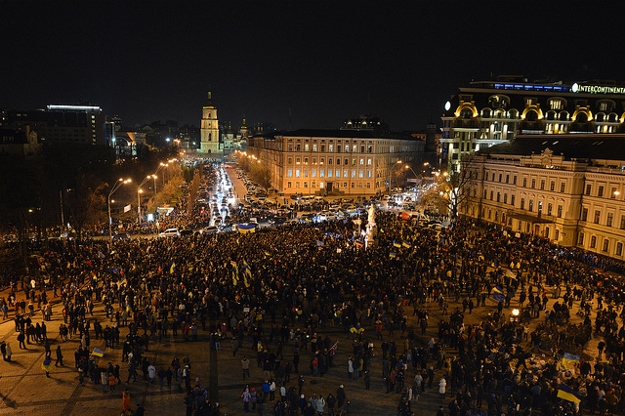
Over 40 Ukrainian and foreign media professionals were assaulted during protests in Kiev against the decision made by government and president Viktor Yanukovych to postpone signing the Association Agreement with the EU, according to news.liga.net.
Many of the journalists were beaten by police soldiers during street clashes initiated by alleged instigators present in the crowd. As a result, organizations from around the world, European officials and international media outlets expressed concern about this situation.
In addition, the local internet provider Volya (i.e. “Will”) announced that it would offer free internet access to protesters in the Independence Square in Kiev, where hundreds of thousands gathered to protest. The Ukraine office of Reporters without Borders also announced that journalists can pick up vests, respirators, goggles, hard hats and stickers from their headquarters on 32A Chervonoarmijs'ka Street in Kiev.
According to Novayagazeta.ru, it is for the first time since Ukraine obtained independence that so many journalists were attacked during a single day – Sunday, December 1st.
Zoya Kazanzhy, a journalist from Odessa, tried to collect information about all attacks on her colleagues. She mentioned that such events are usually covered by professional journalists, who know how to act in extreme situations. The list is being constantly updated, according to news.liga.net, and it includes journalists from Euronews, Associated Press, The New York Times and Agence France Press.
This is the list of cases registered so far:
1. Journalists from Hromadske.tv, Dmitriy Gnap and Yacov Libchik, were beaten, their cameras were broken, and the flash drives taken.
2. Stones were thrown at the filming crew of the Kanal 5 Ukrainian TV station.
3. Dmitriy Prihna, a journalist of the Ryadom S Vami (i.e. ”Next to You”) agency, was beaten by police soldiers despite having shown them his press badge.
4. Roman Kupriyanov, a Euronews cameraman, was filming a man lying on the ground after being beaten by the police. Members of the Berkut special forces told him to stop filming, but he continued. Then police soldiers started beating Roman, who was later taken to hospital.
5. Polish journalist Pawel Pieniazek was beaten by special police forces. He had been filming the events near the Presidential building when he received 10 strikes which lead to a serious head injury.
6. LIGA Business Inform photojournalist Aleksandr Perevoznik was attacked during clashes on the Bankovaya street.
7. A stun grenade thrown by masked officers exploded at the feet of Valeriya Burlakova, a journalist of Ukrainskii Tizhden. The woman was injured.
8. A journalist of Ukrainskaya Pravda was hit in the head.
9. A stun grenade also injured Max Levin, a journalist from Leviy Bereg publication.
10. The editor-in-chief of a newspaper from Zhitomir, Vlad Puchich, was also assaulted.
11. A photojournalist of Agence France Presse (AFP), Sergey Supinskiy, was beaten.
12. Photojournalist Maxim Kudinets of Insider, was also beaten. He said that policemen had been hitting his camera to stop him from filming.
13. Sergey Chuzavkov, a correspondent for Associated Press (AP), was injured as a result of clashes between protesters and the police.
14. A cameraman of UBR TV, whose name was not confirmed, was also assaulted.
15. Dmitriy Larin, a journalist of Ukrainskaya Pravda, claims he was attacked by Berkut police soldiers while filming the clashes.
16. Photographer Anatoliy Stepanov says that policemen fractured his head and an arm. He claims that he introduced himself to Berkut agents as a journalist, which made them become even more violent.
17. A fragment of a stun grenade penetrated journalist Ivan Chernichki's leg during clashes near the Presidential administration.
18. Cameraman Alexandr Zakletskiy was beaten by the police with rubber truncheons and hit with the feet. Also, authorities tried to destroy his camera.
19. Anatoliy Chernyshov of the Independent Union of Journalists was beaten by police and his camera taken and destroyed.
20. Denis Dan’ko and Dmytro Volkov, of the Groshy TV show, were both hit in the head.
21. A stun grenade exploded at the feet of Yaroslav Galata of Demokraticheskaya Ukraina newspaper.
22. Zhitomir.info photographer Mihail Zagorskiy was filming the protest from a windowsill when he saw policemen hitting one of his colleagues. He jumped to help, but was also beaten with rubber truncheons.
23. A Berkut police soldier threw a stone at the back of Dmitriy Kachura, a reporter of Ukrainskie Novosti.
24. Yevgeniy Golovenko, another reporter from the above-mentioned publication, lost consciousness after a stun grenade exploded next to him.
25. Berkut policemen also beat the deputy editor-in-chief of Comments.ua.
26. Sergey Dolzhenko, EPA agency photojournalist, was assaulted too.
27. Censor.net.ua editor Yuri Butusov was also beaten. He wrote that Berkut agents were checking to see if the people that had fallen to the ground after being beaten were still conscious. If they were, they would hit them again.
28. Three policemen hit a cameraman from the Lifenews.ru television with rubber truncheons across his arms and hands. Later, they also destroyed his camera.
29. Photojournalist Andrey Stenin of RIA Novosti was beaten with stones.
30. Photojournalist Zurab Dzhuvanidze of ITAR-TASS was beaten with rubber truncheons.
31. Cameraman Sergey Polezhaka was hit over the hands while filming.
32. Yevgeniy Maloletka, a UNIAN photojournalist, claims that he was attacked by police after they found out he was a journalist.
33. A journalist of Izvestiya was injured after a stun grenade exploded near him.
34. Igor Volosyankin of Uezd.com.ua was beaten with stones and inhaled gas during police intervention.
35. The editor of Aratta.Vikno website was beaten by at least six policemen.
36. A reporter of Novoros.Info, Sergey Yurchenko, was seriously injured during clashes. He also lost the flash drive with his video recording.
37. Photojournalist Alexandr Terlyuk has a hematoma after suffering a brutal attack.
38. A photojournalist of the American newspaper The New York Times, Joseph Sywenkyj, was injured by the explosion of a stun grenade.
39. Polish journalist Tomas Peczala was beaten by police on Saturday.
40. Danish journalist Johaness Wamberg Andersen was hit in the head while filming protests on the night of November 30th.
41. Reuters photographer Glib Garanich suffered a head trauma after clashing with Berkut special forces.
42. Natalia Figel of Vidia news portal had her camera destroyed by an unidentified person in the crowd.
43. Evgeny Feldman of Novaya Gazeta was beaten with stones hext to Lenin's monument.
44. Photographer Mstyslav Chernov of Mediaport.ua was also beaten by Berkut officers.
45. Olexandr Jogalko was injured due to a stun grenade explosion.
46. Russian photojournalist Vassily Maximov, stringer for AFP, suffered injuries to the knees after a stun grenade exploded at his feet.
47. Ivan Marusenko of Censor.net.ua was also hit by a stun grenade.
48. Denys Bigus of ZIK TV station was hurt during tear gas attacks.
49. Lesya Koval of Ukraine TV channel was helping the injured near the Writers' Union, along with her mother. Berkut forces tackled her to the ground and beat her. When she told them she was a journalist, they started cursing at her.
50. Alex Osyka, TSN cameraman, was hit by a rock thrown by a Berkut agent.
51. Photojournalist Oleksandr Furman of Delo.ua was also beaten by a police officer.
52. Journalist Valeriy Garaguts, founder of Litsa newspaper, said, through his lawyer, that while he was lying on the ground with other injured protesters, Berkut officers were photographing themselves next to the victims, lifting them up and calling them "meat".
Forceful police intervention during protests sparked serious international concern
On December 2nd, Dunja Mijatović, the OSCE Representative on Freedom of the Media, expressed her concern regarding the magnitude of violence against journalists during the protests in Kiev.
“I am especially concerned that in most of the cases, the beatings were reportedly conducted by the law enforcement officers who attacked the journalists and disregarded their press identification. Violence against journalists cannot be tolerated,” Mijatović wrote in a letter to OSCE Chairperson-in-Office, Ukrainian Foreign Minister Leonid Kozhara.
European Parliament President Martin Schulz also said that the use of force against peaceful demonstrators in Ukraine is “simply unacceptable”.
The Economist wrote that “thugs and thieves always prefer to act in the early hours of the morning. So did Viktor Yanukovych, Ukraine’s president.” British newspaper The Independent announced that the police “cleared” the Independence Square early on Saturday morning and isolated the zone with metal barricades, but had to abandon them on Sunday after hundreds of thousands of people came out in the streets. British daily The Guardian named the protests the greatest mobilization of society since the Orange Revolution. Radio Free Europe / Radio Liberty created a live blog where it constantly posts news about the protests. Also, the American Forbes published a comment about the lessons to be learned from the Ukrainian situation and what the country’s integration with the EU actually signifies. Kyiv Post also keeps a daily log of events in Ukraine's capital and the political class' reactions.
On social media, pro-European journalists and youth of Ukraine call for solidarity and intense promotion of the situation in Kiev and other cities of the country. Under the hashtags #euromaidan, #Євромайдан, #ukraine, #kiev on Facebook and Twitter they post messages of solidarity, information for protesters and journalists, photos and video from protests, as well as articles from international media. The official page of the movement is ЄвроМайдан, with the English-language version Euromaidan.
Sources of photo: mac-ivan via Flickr Creative Commons; Ilya Varlamov via www.zyalt.livejournal.com.










